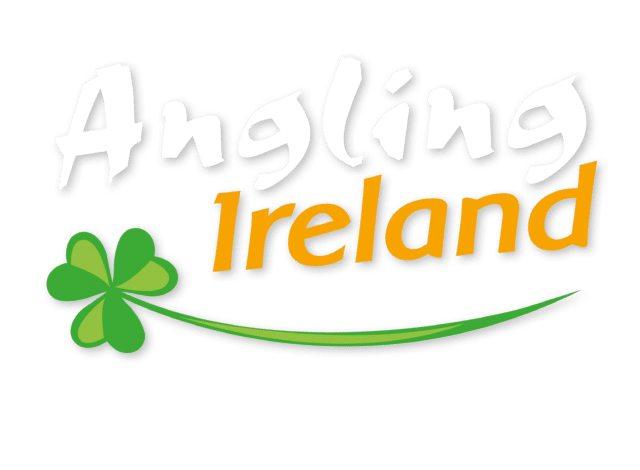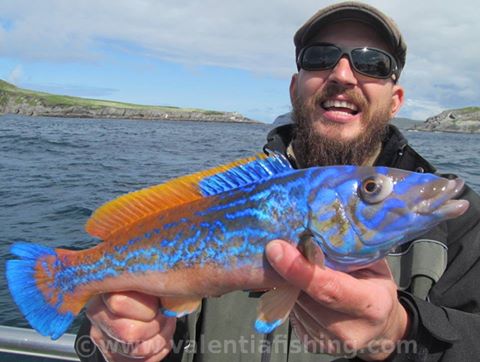Bass (Dicentrarchus labrax)
This blue backed, silver cousin of the American striped bass is one of Ireland’s most sought after sport fish. It is equally at home in the turmoil of an Atlantic surf beach or in the quietness of an estuarine backwater. Most common below a line drawn from Galway to Dublin, but localised populations exist in the northern region. Grows to about 20 lbs. Specimen weight 10 lbs. A protected species by law, minimum size and other restriction apply. Find out more about bass fishing here.
Flounder (Platichthys flesus)
Eyes and colour normally on the right side, but “reversed” examples are more common amongst flounders than among other flatfishes. Conspicuous enlarged, rough, hard scales on head ridge, anterior part of lateral line and along bases of dorsal and anal fins on the eyed side. Dark brown to greenish-grey, sometimes with vague orange spots; blind side uniform opaque white. Grows to about 5 lbs. Often occurs in fresh water well above the limits of the tide. Specimen weight: 1.36kg. (3 lbs).
Turbot (Scophthalmus maximus)
Turbot are large flatfish and are regarded as one of the major prizes of Irish sea angling and they are also highly regarded for the table. The upper side is a mottled brown with numerous bony lumps or tubercules. The body is diamond shaped. Turbot can grow to over 40lbs.
Pollack (Pollachius pollachius)
Very popular sport fish. Can be taken from both boat and shore on the northern coast. Common over areas of rough ground, reefs and sunken wrecks. Easily identified from its near relation, the coalfish, by the protruding lower jaw and by the shape of the lateral line which is bent over the pectoral fin. Tail not forked. Usually brown or bronze on back and flanks. Grows to over 20 lbs. Specimen Weight, 12 lbs.
Cod (Gadus morhua)
Common on most coasts and unlikely to be mistaken for any other species, even though the colour of adults varies. Caught over a wide range of seabed from reefs and wrecks to areas of shingle and sand and in many of the larger estuaries. Cod are available throughout the year, but generally “peak” fishing times are May and June (boat angling) and December and January (shore fishing). Grows to over 50 lbs. Specimen Weight, 20 lbs.
Ling (Molva molva)
Long, eel-like, member of the cod family which has a large barbel under the chin and a mouth of sharp teeth. Olive or red-brown in colour, sometimes mottled. A very popular sport fish, particularly with wreck and reef anglers. Almost exclusively a boat caught fish. Grows to about 50 lbs. Specimen Weight; 11.34 kgs (25 lbs).
Wrasse (Lubrus)
Large family of deep bodied, hard scaled fish. Two species are of interest to Irish anglers: the Ballan Wrasse (Labrus bergylta) which grows to about 10 lbs (specimen weight, 4.75 lbs) and the colourful Cuckoo Wrasse (Labrus mixtus) (which grows to around 2 lbs (specimen weight, 1.25 lbs). Both are very common in Irish waters particularly where there are rocky areas of weed covered reef.
Gurnard (Triglidae)
There are three species of Gurnard which anglers can expect from waters in the northern region. Grey Gurnard (Eutrigla gurnardus) which grows to about 3.5lbs; Red Gurnard (Aspitrigla cuculus) which grows to about 4lbs and Tub Gurnard (Trigla lucerna) which grows to over 12lbs. Gurnards are bottom living fish, normally found on sandy or muddy bottoms in depths of 50-150 feet.
Conger Eel (Conger conger)
Dorsal, caudal and anal fins continuous; no pelvic fins. Dorsal begins about level with tip of pectoral. Body rather stout and muscular. Mouth large; the upper jaw the larger. Grows to over 100 lbs. Offshore, inshore and in lower reaches of large estuaries. Specimen weight: 18.14kg. (40 lbs).
Skate (Raja)
Three species of skate have been recorded by anglers in Irish waters. They are:- White Skate (Raja alba) (specimen weight 120 lbs); Long Nose Skate (Raja oxyrinchus) (80 lbs); and Common Skate (Raja batis) (specimen weight suspended). In the interests of conservation, the Irish Specimen Fish Committee removed the Common Skate from its list of acceptable species in 1976. Since then, all Common Skate taken by anglers have been returned alive to the water. In recent years, fish to almost 200 lbs have again re-appeared in the northern region.
Ray (Raja)
Popular with boat and shore anglers and often confused with skate; but those with more rounded discs and short noses are generally termed ray. Normally a summer species they are available from May to October. Four species of ray are of interest to anglers in the northern region. They are Thornback Ray (Raja clavata) (specimen weight 20 lbs); Blonde Ray (Raja brachyura) (25 lbs); Cuckoo Ray (Raja naevus) (4.5 lbs); Homelyn Ray (Raja montagui) (5 lbs).
Shark
There are five species of shark which anglers may contact in Irish coastal waters. They are the Mako (Isurus oxyrinchus), Thresher (Alopias vulpinus), Six Gilled (Hexanchus griseus), Porbeagle (Lamna nasus) and the Blue (Prionace glauca). Of these, only the latter two are caught with any degree of regularity in the northern region, the others being mainly accidental catches. Shark fishing is very popular during the summer months.
Tope (Galeorhinus galeus)
Medium sized shallow water shark, fairly common on the northern coast of Ireland during summer. Greyish in colour with short, triangular pectorals and deeply notched tail fin. Very popular sport fish, particularly with inshore boat anglers. Male fish to 30 lbs are often encountered in “packs” (Lough Swilly) but much larger females are either “loners” or are found in small groups. Grows to about 80 lbs. Specimen weight, 40 lbs.
Angling Exotics in the South West
Albacore tuna – Frequent visitor in September to region, charter boats need to be researched by anglers and information is available on our website.
Gilthead Bream – Establishing as a sport species in Cork area. It is quite common in some areas.
Trigger Fish – Common in last few years throughout the South West coast.
Sting Ray – Prolific sport species caught from the shore at Tralee bay.
Undulate Ray – Caught occasionally at Tralee Bay.









